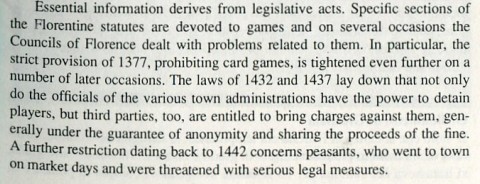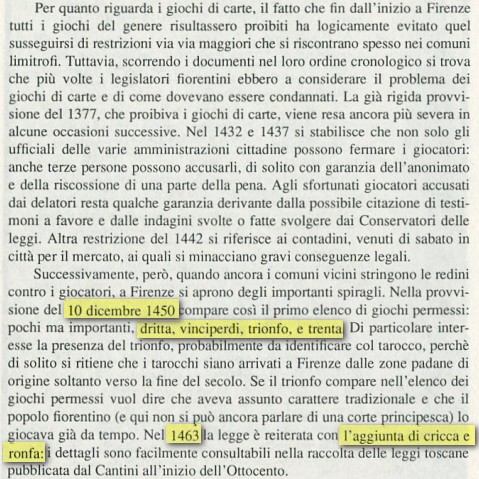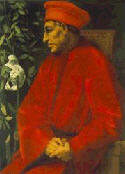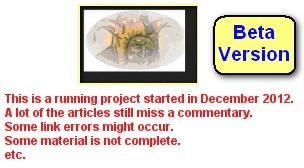Document 28 [old counting]
Florence, 1463
Similar decree to that of December 1450, now together with the allowance of Ronfa and Cricce.
(Source: Franco Pratesi)
It's the first Italian note to the game Ronfa (this game is first noted in France 1414). Compare the article to Ronfa.
Interpretation of the document (stand May 2006)
Generally I see a first Trionfi card movement in the years 1441-1442 and a second phase between 1450-1454. The document of 1463 might indicate a 3rd greater phase, which finally did lead to develop Trionfi cards in mass production in the 70ies of 15th century. In the discussion I mentioned:
"When Florence made a restart in matters of Trionfi deck production 1463 and moved a little bit to mass production, then the general situation changed of course. In Ferrara the courtly production of Trionfi cards stopped 1463 ... this might indicate, that the theme has lost its exclusivity and perhaps became uninteresting for the idle duke Borso just with the popularization in Florence.
When we assume a "restarted" Trionfi deck production in Florence, we should observe, what happened in Florence just in this year:
- Giovanni di Medici died, his brother Pietro became the new heir in th Medici house.
- The Villa in Careggi becomes the new home of the Platonic Academy.
- Lorenzo beccame 14 years old (a crucial year, he was then perceived as grown-up).
- Luigi Pulci, who in 1461 entered the service of the Medici and has strong influence on the young Lorenzo.
- Both remaining older Medici (Pietro and Cosimo) are rather sick: Cosimo will die soon. Pietro cannot move himself easily. All expectations look at the young Lorenzo.
Card playing was for young persons. The logical reason for the new production in Florence is the adolescence of Lorenzo. Pulci should be the poetical spirit behind it, but of course the more noble members of the academy are also of influence.
1466: Later Pulci writes the letter to Lorenzo, in which he mentions the word Minchiate. Pulci in 2 of his poems uses words, which ironize the word Minchiate (these words and their meaning are unclear ... these words are only used by Pulci, as far the internet knows them).
I could imagine, that there were 2 (or even more) creative Florentine outputsin the time 1463 - 1466): One a little more serious and more influenced by the serious members of the Platonic academy and still called "trionfi cards" (1463), and then a next version called "Minchiate" and prefering humorous aspects and dominated by Pulci's influence (later, perhaps 1465 or 1466).
And we've the 6 cards, which are added to the Pierpont-Morgan-Bergamo-deck as another relict of the "creative time in Florence" (according to my own interpretation)."
| |
| SOURCE 2: Gambassi (Florentine territory), 1451 Statute with Trionfi game allowance
|
Reported in "The Playing-Card, Vol. 40 No. 3", (2012) p. 167
| SOURCE 3: Asinalunga (Sienese territory), 1451 Statute with Trionfi game allowance
|
Reported in 1451 - NEW LAWS AGAINST GAMBLING IN SIENA by Franco Pratesi, 24.04.2012
| SOURCE 4: Ancona, c. 1460 Statute with Trionfi game allowance
|
Quotes mainly from the earlier Trionfi notes collection of Trionfi.com (2003-07): Document 25b [old counting] / Statutes Florence 1450. Naturally these older texts present not in all points my opinion of nowadays.
The new text here might contain some corrections against the earlier versions.
|
Document 25b [old counting]
1460/1513, Ancona - allowance
Found by Thierry Depaulis:
Cyriaque d'Ancône: le voyageur, le marchand, l'humaniste by Jean Colin, 1981, notes at p. 95:
|
Constitutiones sive Statuta magnifice civitatis Ancone [1513] ... interdit le "ludum taxillorum" (= dés, moriola, etc.), mais permet, sous certaines conditions, le "ludus tabularum, chartarum, triumphorum" (jeu de pios sur une tableau, de cartes, etc.)
|
"Constitutiones sive Statuta magnifice civitatis Ancone" is given as codified in 1460, published in 1513 (in my opinion it's perhaps not reliable, that the text is really from 1460 or entered the printed edition of 1513 in a modified form, often such later prints are changed according to the Constitutions of the time; Schreiber (1938) behaved sceptical in such cases).
The note of Ancona is one of three of a rather isolated region at the Eastern coast of Italy (near to Fabriano and Ancona). These, together with the notes in Rome and Naples, which more or less all appear in the 70's of 15th cebtury, show, that the Trionfi evolution in Southern Italy took place 20-30 years after the first developments in Northern parts of Italy.
|

Southern development (first notes)
- 1450 Florence
- 1452 Siena
- 1452 Rimini
- 1460 ? Arcona
- 1473 Naples
- 1474 ? Rome
- 1476 Fabriano
- 1480 ? Recanati
|
|
|
Repeated Note:
When Ross Caldwell and me in 2003 started to collect Trionfi notes between 1442-1463, we had about 27/28 entries (which I nowadays would count as 31). The major part were the documents of Ferrara, which were collected by Gherardo Ortalli and Adriano Franceschini in the "Prince and the Playing Cards" (1996), after the base laying works of Michael Dummett and Stuart Kaplan around 1980. This collection included 2 notes about Trionfi cards in Florence, found by Franco Pratesi in his earlier work (allowances of the Trionfi game in 1450 and 1463). A graphical representation of this time (with 27 entries) shows the dominance of Ferrarese documents (in black) with a few notes only from other locations (in red; see picture to the right)
In the period 2004 till October 2011 it was possible to add 4 further notes (Siena 1452, Padova 1455, Ancona c. 1460 and Valerio Marcello c. 1460), mainly thanks to information given by Thierry Depaulis.
Franco Pratesi started his new article series in November 2011. Since then the list has gotten 67 new documents till September 2012 (65 of them found by Franco Pratesi, one, now the oldest of September 1440, by Thierry Depaulis, and another one by Veber Gulinelli, who controlled the earlier work of Franceschini and found an overlooked document) and nearly all are related to Florence or its surrounding.
A small book (118 pages) was published around Christmas 2012, Franco Pratesi: "Playing Card Trade in 15th Century Florence" as IPCS Paper No. 7 (ISSN 0305-2133). It contains some of the articles, which before had appeared at this website, those, which treat the early time of 15th century. Thierry Depaulis commented in his foreword: "This book is a landmark in the history of early playing cards in Italy".
Well, maybe not the book, but the research is clearly a landmark in various interests. For the collection of early Trionfi notes it somehow means, that we have within the year 2012 about 200 % more data for the period 1440-1462 than mankind had collected in the 200 years before.
Added later:
In August 2013 the new report of Arnold und Doris Esch: "Aus der Frühgeschichte der Spielkarte. Der Import von carte da giocare und trionfi nach Rom." in Gutenberg Jahrbuch 2013, 88. Jahrgang, p. 41-53, arrived in our redaction. It contains 106 new references to Trionfi decks, which all were found in the customs registers of the city Rome for the period 1453-1465. With this the number of all earlier Trionfi cards records has been doubled and should have reached then c. 210 (from which a few are only considered to be "Trionfi card notes" and don't contain the word "Trionfi" or something similar).
***********
I'd started to sort the new Trionfi card documents overview in October 2012. Articles will be possibly changed according improvements in research.
|
Old Overview about Trionfi Card documents in 2003

Overview about Trionfi Card documents in 2013
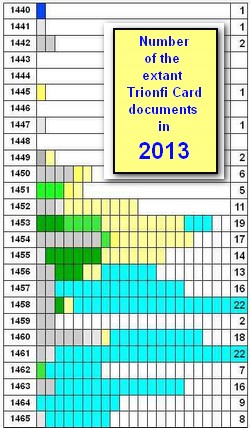 READ MORE
READ MORE
|
|
